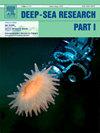在北太平洋为阿拉斯加西部鲑鱼绘制合适的热迁移通道
IF 2.1
3区 地球科学
Q2 OCEANOGRAPHY
Deep-Sea Research Part I-Oceanographic Research Papers
Pub Date : 2025-05-20
DOI:10.1016/j.dsr.2025.104531
引用次数: 0
摘要
很明显,变暖的北太平洋(NPO)温度正在影响鲑鱼的健康和生存。育空河在2020年和2021年记录了阿拉斯加西部鲑鱼洄游规模的最低记录。根据最近对太平洋鲑鱼物种特有的海洋温度偏好的分析,鲑鱼具有最广泛的温度偏好范围;我们之所以关注熟鸟,是因为它们可能对温度变化有最大的适应能力,如果它们的活动范围受到影响,其他物种很可能也会对观测到的变暖做出反应。根据游泳率绘制了季节性迁徙的热适宜性图,以检查潜在的年际范围或分布变化。为了测试海洋物理对鲑鱼迁移和分布的影响,研究人员建立了两个基于个体的模型,分别由地表温度和地转流驱动。我们发现,在过去十年中,海洋温度与预计到2050年的幅度和可变性相似。自2013年左右以来,高适宜性迁徙走廊向北转移到白令海,但季节性迁徙可能主要不是由温度或洋流驱动的。海洋温度升高、海洋热浪和季节性海冰的减少可能会对阿拉斯加西部的鲑鱼产生最大的影响,因为那里的热适应性最低——冬季在白令海,夏季在阿拉斯加湾东部。对其栖息地范围边缘的影响可能导致环境恶化,向北转移,以及更多的鱼类进入北冰洋。本文章由计算机程序翻译,如有差异,请以英文原文为准。
Mapping suitable thermal migration corridors for western Alaska chum salmon in the North Pacific
It is evident that warming North Pacific Ocean (NPO) temperatures are impacting salmon fitness and survival. Record-low western Alaska chum salmon run sizes were recorded in the Yukon River during 2020 and 2021. Based on recent analyses of Pacific salmon species-specific ocean temperature preferences, chum salmon have the widest thermal preference range; we focus on chum because they may have the greatest resilience to temperature variability and if their range is impacted, it is likely other species will respond to observed warming as well. Thermal suitability was mapped along the seasonal migration based on swimming rates to examine potential interannual range or distribution shifts. Two individual-based models of salmon migration driven by surface temperatures and geostrophic currents were run to test the impact of ocean physics on migration and distribution. We found that in the last decade ocean temperatures have similar magnitude and variability as projected through 2050. Since around 2013, the high suitability migration corridor has shifted northwards into the Bering Sea, but the seasonal migration may not be driven primarily by temperature or ocean currents. Warmer ocean temperatures, marine heatwaves, and loss of seasonal sea ice are likely to have the greatest impacts on western Alaska chum salmon where thermal suitability is lowest–in the Bering Sea in winter, and in the eastern Gulf of Alaska in summer. The impacts at the margins of their habitat range may lead to poor condition, a northward domain shift, and more fish entering the Arctic Ocean.
求助全文
通过发布文献求助,成功后即可免费获取论文全文。
去求助
来源期刊
CiteScore
4.60
自引率
4.20%
发文量
144
审稿时长
18.3 weeks
期刊介绍:
Deep-Sea Research Part I: Oceanographic Research Papers is devoted to the publication of the results of original scientific research, including theoretical work of evident oceanographic applicability; and the solution of instrumental or methodological problems with evidence of successful use. The journal is distinguished by its interdisciplinary nature and its breadth, covering the geological, physical, chemical and biological aspects of the ocean and its boundaries with the sea floor and the atmosphere. In addition to regular "Research Papers" and "Instruments and Methods" papers, briefer communications may be published as "Notes". Supplemental matter, such as extensive data tables or graphs and multimedia content, may be published as electronic appendices.

 求助内容:
求助内容: 应助结果提醒方式:
应助结果提醒方式:


